HOME > CORE SERVICES

The primary activities of uMngeni-uThukela Water, as pronounced in section 29 of the Water Services Act, is to provide water services (water supply and sanitation services) to other water services institutions in its service area.
In addition, section 30 of the Water Services Act, enables uMngeniuThukela Water to undertake other activities, provided they do not impact negatively on the entity’s ability to perform its primary activity.
These include:
uMngeni-uThukela Water established two subsidiary companies, Msinsi Holdings SOC Ltd (“Msinsi”) and Umgeni Water Services (UWS) SOC Ltd to advance its water service delivery mandate.
Msinsi is a company primarily established to focus on the management and conservation of major water resources located in the Mgeni River System and continues to extend its presence in other areas in line with its approved corporate plan and shareholder compact. The Mgeni River System supplies the Msunduzi Local Municipality and eThekwini Metropolitan Municipality.
UWS is an agile frontend company established primarily to drive the expansion of the Group’s operational and business footprint through collaborating with stakeholders in finding viable solutions to the challenges experienced by water providers in the water sector.
The core bulk water and wastewater business is undertaken in a manner that serves customers and stakeholders most effectively. As part of the value chain function, raw water is carefully abstracted from dams, rivers and borehole sources and conveyed using both gravity and the most effective pumping options to bulk water treatment works, where it is treated to meet SANS 241 quality standards and distributed to customers.
Equally, with regard to wastewater treatment, effluent is received from municipal sewer systems, treated at bulk wastewater treatment works and effluent is discharged back into receiving systems mindful of the quality and potential impacts on receiving systems and potential for reuse.
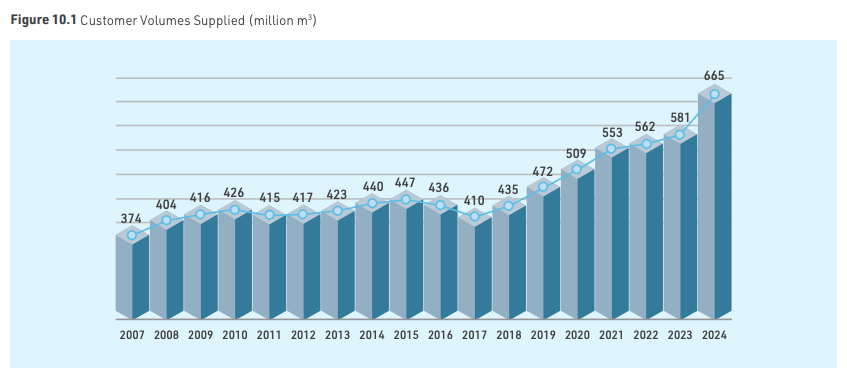
uMngeni-uThukela Water’s infrastructure assets in support of its bulk water services business comprise of:
A total of 665 million cubic metres of potable water per annum (1 822Ml/d) were supplied to customers (Figure 10.3) who serve a population of 6.7m or 1.9m households through reticulation networks.
This is a 2.7% year-onyear increase as compared to the previous year. Treatment works’ capacities and utilisation are shown in Figure 10.4 (a) and (b) respectively.
In the year under review, there were unplanned supply disruptions of 12.73 supply days in four of the 16 supply systems as follows :
In all such instances including planned disruptions, customers are kept informed on progress of any interventions. uMngeni-uThukela Water continues to engage regularly with its customers in line with service level agreements.
Bulk wastewater treated from eleven inland Wastewater Treatment Works over this period amounted to 31 million cubic metres (85Ml/d) for the year per annum, a 5% increase from the previous year (29.5 million cubic metres or 81Ml/d in 2023). Wastewater Treatment Works’ (WWTWs) capacities and utilisation are shown in Figure 10.4 (c) and (d) respectively.
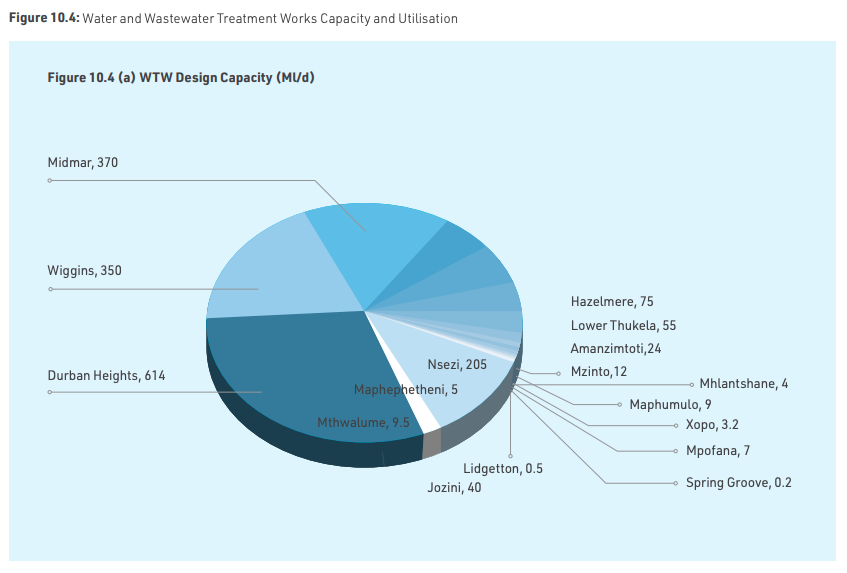
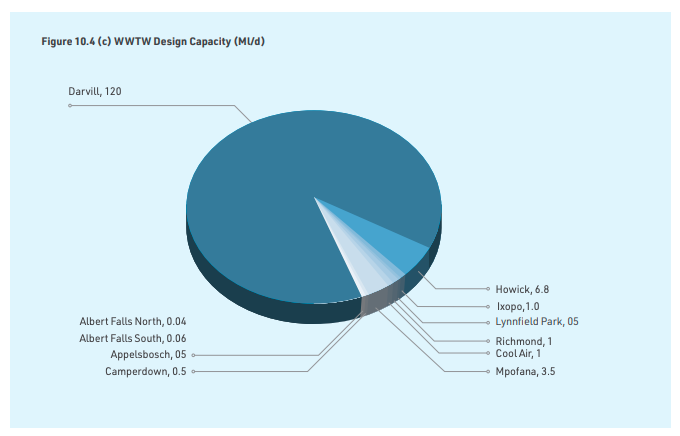

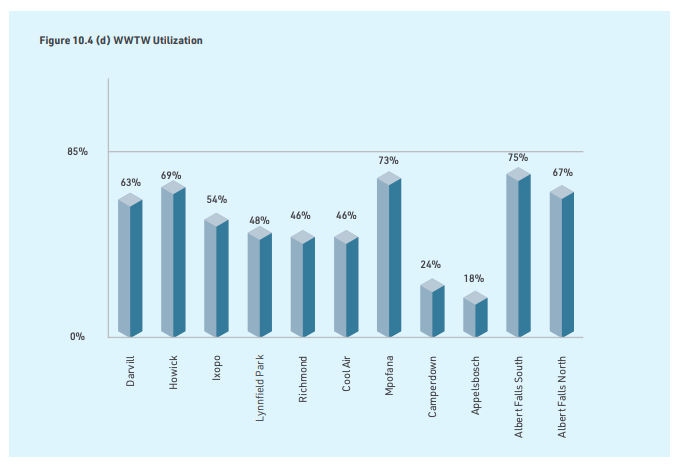
Bulk Supply Agreements
Bulk Supply Agreements are concluded to cover obligations of both uMngeni-uThukela and its customers in relation to water volumes, water quality, supply pressure, service interruption intervals, metering, tariff consultation, assurance of supply and capital infrastructure plans.
Water demand projections are updated based on trends in historical water sales volumes and customer demand trends. In parallel, analysis of uMngeni-uThukela Water’s bulk infrastructure and water works capacity in relation to demands highlight any infrastructure supply constraints or limitations on future growth that need to be responded to.
Supply Capacity and Constraints
Several works, as shown in Figure 10.4 (b) are currently operated above their design capacity to meet demands, and both long- and short-term interventions are in place to address them including major works capital upgrades, refurbishments, pipeline developments, utilisation of package plants (interim measure) and general operational and process upgrades to alleviate bottlenecks.
The quality of potable water is paramount to uMngeni-uThukela Water, thus the organisation endeavours to ensure that the quality of potable water produced within its operational area is safe for human health over a lifetime of consumption. To achieve this, a comprehensive water quality management programme is implemented throughout the supply area. The programme adopts a riskbased approach including monitoring programmes, water quality assessments, system audits, compliance reporting and water safety plans embracing the catchment to consumer concept.
The risks associated with abstraction, conveyance, treatment and bulk distribution are reviewed constantly to ensure control effectiveness and quality assurance. Potable water quality incidents are managed in accordance with an Incident Management Protocol aligned to the requirements of the South African National Drinking Water specification (SANS 241:2015).
In addition to providing safe drinking water and protecting public health, uMngeni-uThukela Water is also committed to ensuring that wastewater discharges are not harmful to the environment and downstream users. This is achieved through the development and implementation of wastewater risk abatement plans that include comprehensive and site specifi c risk assessments, the implementation of corresponding mitigation plans and site specific incident management protocols to manage wastewater incidents and non-compliances.
All potable and wastewater sampling and analysis are undertaken in accordance with an ISO 9001 certified monitoring programme and SANAS 17025-accredited laboratory methods. Information on water quality performance is regularly conveyed to customers, stakeholders and regulators in accordance with the organisational stakeholder communication plan.
The South African National Drinking Water Specification (SANS 241:2015) dictates the compliance requirements for potable water supply systems. The performance of each system is reported against the following five risk categories specified in SANS 241:2015 (as per the classification tabulated further below):
(1) Acute Microbiological Health;
(2) Acute Chemical Health;
(3) Chronic Chemical Health;
(4) Aesthetic;
(5) Operational Categories.
| Population up to 100 | Population > 100 000 | |||||||||
|---|---|---|---|---|---|---|---|---|---|---|
| Proportion of sales compliant | Proportion of sales compliant | |||||||||
| Excellent | Good | Unacceptable | Excellent | Good | Unacceptable | |||||
| Accute Microbiological Health | =>97% | =>95% | =>95% | =>99% | =>97% | =>97% | ||||
| Acute Chemical Health | =>97% | =>95% | =>95% | =>99% | =>97% | =>97% | ||||
| Chronic Chemical Health | =>95% | =>93% | =>93% | =>97% | =>95% | =>95% | ||||
| Operational | =>93% | =>90% | =>90% | =>95% | =>93% | =>93% | ||||
| Aesthetic | =>93% | =>90% | =>90% | =>95% | =>93% | =>93% | ||||
During the reporting period,13 uMngeni-uThukela Water bulk water supply systems and three uMgungundlovu District Municipality (UMDM) schemes were monitored and reported against the five risk categories as specified in SANS 241:2015.
Overall, the combined compliance of the uMngeni-uThukela Water bulk potable water supply systems was excellent for the period under review. Compliance per SANS 241:2015 risk category is shown in Figure 2.1. Detailed potable water quality compliance per water supply system is shown in Table 2.1.
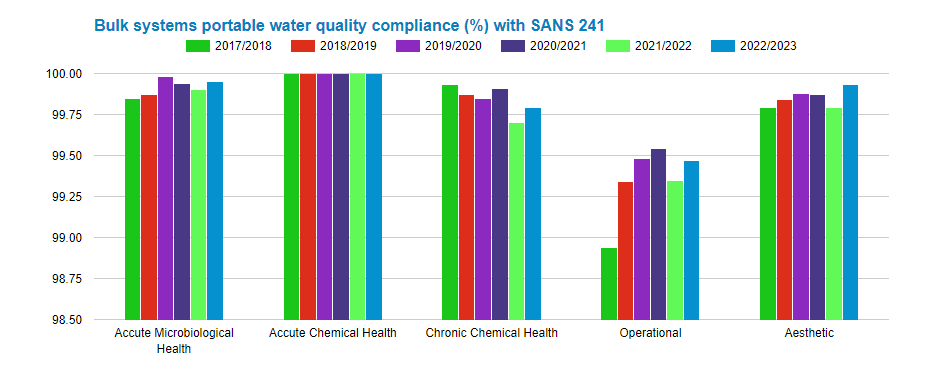
| Water Supply System | Average Daily Volume Treated (MI/d) | % Volume | Acute Microbiological Health | Acute Chemical Health | Chronic Chemical Health | Operational | Aesthetic |
|---|---|---|---|---|---|---|---|
| Durban Heights | 527 | 33.56% | 100 | 100 | 100 | 99.84 | 100 |
| Wiggins | 302 | 19.23% | 100 | 100 | 100 | 99.73 | 100 |
| Midmar | 367 | 23.37% | 99.85 | 100 | 100 | 99.58 | 100 |
| DV Harris | 116 | 7.39% | 100 | 100 | 100 | 99.88 | 100 |
| Amanzimtoti | 87 | 5.54% | 99.74 | 100 | 99.89 | 98.87 | 99.79 |
| Hazelmere | 72 | 4.58% | 100 | 100 | 99.93 | 97.74 | 99.02 |
| Lower Thukela | 48 | 3.06% | 100 | 100 | 100 | 99.27 | 100 |
| Maphumulo | 7.0 | 0.45% | 99.52 | 100 | 100 | 90.62 | 98.68 |
| Umzinto | 13 | 0.83% | 100 | 100 | 100 | 99.67 | 100 |
| Mtwalume | 13 | 0.83% | 100 | 100 | 100 | 100 | 100 |
| Mhlabatshane | 7.0 | 0.45% | 100 | 100 | 100 | 99.64 | 100 |
| Maphephetheni | 4.0 | 0.25% | 100 | 100 | 100 | 99.09 | 100 |
| Ixopo | 2.0 | 0.13% | 100 | 100 | 100 | 98.75 | 98.08 |
| Mpofana | 5.0 | 0.32% | 100 | 100 | 100 | 99.61 | 100 |
| Rosetta | 0.2 | 0.01% | 98.08 | 100 | 100 | 99.04 | 99.25 |
| Lidgetton |
Compliance Per System
Twelve (12) uMngeni-uThukela Water bulk water supply systems showed excellent compliance with all monitored SANS 241:2015 risk categories, while Maphumulo WTW’s reported Good performance for the operational risk category. The Good performance recorded was due to elevated coliforms, turbidity, heterotrophic plate count and inadequate disinfection associated with poor performance of the package plant which affects the final water and the offsite reservoirs. The package plant cleaning was completed and will be added to the Planned Maintenance (PM) programme on a quarterly frequency, the turbidity meter was replaced and plant upgrade is anticipated to take place in 2023.
The uMgungudlovu District Municipality’s drinking water supply systems recorded a combined excellent performance against all the risk categories specified in SANS 241:2015.
Figure 2.2 and Table 2.2 show wastewater quality compliance per system, assessed against the relevant licence or General Authorisation General Limits prescribed by the Department of Water and Sanitation (DWS).
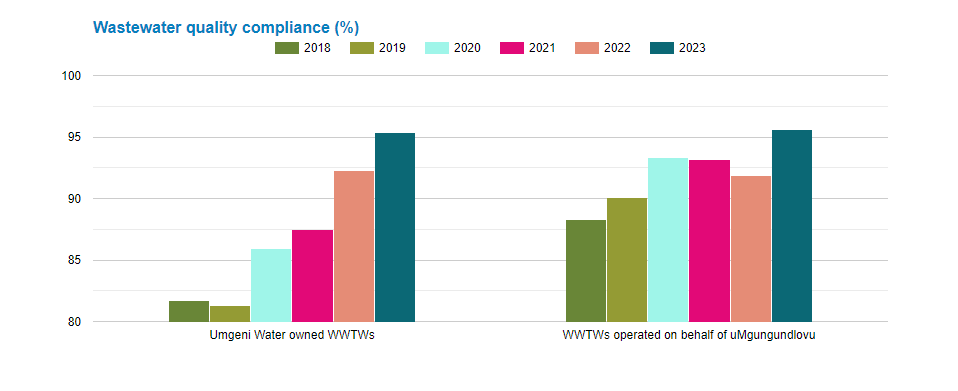
| Waste Water Treatment Works | Average Daily Volume Treated | Percent (%) Compliance | |||||||||
|---|---|---|---|---|---|---|---|---|---|---|---|
| (Ml/D) | (%) | 2018 | 2019 | 2020 | 2021 | 2021 Target | 2022 Actual | ||||
| Darvill | 71.99 | 86.45% | 73.8% | 73.7% | 82.2% | 84.45% | =>80% | 90.44% | |||
| Howick | 6.07 | 7.29% | 91.1% | 90.3% | 91.1% | 93.33% | ≥ 90% | 95.56% | |||
| Ixopo | 0.50 | 0.60% | 96.0% | 94.0% | 92.6% | 88.13% | ≥ 90% | 94.58% | |||
| Lynnfield Park | 0.17 | 0.20% | 95.9% | 93.6% | 92.5% | 96.79% | ≥ 90% | 95,65% | |||
| Mpofana | 3.38 | 4.06% | 78.0% | 77.7% | 88.4% | 86.92% | ≥ 90% | 87.30% | |||
| Richmond | 0.68 | 0.82% | 93.9% | 96.7% | 95.3% | 96.67% | ≥ 90% | 99.17% | |||
| Cool Air | 0.36 | 0.43% | 98.2% | 99.6% | 99.5% | 100.00% | ≥ 90% | 98.33% | |||
| Camperdown | 0.08 | 0.10% | 91.7% | 91.7% | 93.1% | 94.44% | ≥ 90% | 100% | |||
| Appelsbosch | 0.04 | 0.05% | 81.9% | 88.9% | 93.1% | 97.22% | ≥ 90% | 93.06% | |||
| Albert Falls North | 0.02 | 0.02% | - | - | - | 100.00% | ≥ 90% | 100.00% | |||
| Albert Falls South | 0.03 | 0.04% | - | - | - | 100.00% | ≥ 90% | 100.00% | |||
Compliance Per System
Compliance for nine (9) wastewater treatment works (WWTW) was assessed against the relevant standard, and only Mpofana WWTW was non-compliant with the set performance target. The Mpofana WWTW achieved 87.30% against the performance target of ≥90.0%. Removal of ortho-phosphate is a frequent challenge at this site as sludge wasting remains an issue. There has been a build-up of old sludge in the process units, which can result in phosphate release. The nitrate non-compliance was caused by an over-aeration. E. coli non-compliance was due to inadequate disinfection that is triggered by the accumulation of solids in the contact tank and reed bed.
The chlorine dosing was maintained at the high range to minimise E. coli failures. Fast-tracking procurement of new dewatering units. Dredging of contact tank and reed bed. The augmentation project will also assist in improving the plant effluent quality. The aerators were operated manually to accommodate diluted flows thus lower organic load. HTH was added to supplement the chlorine gas for effective disinfection.
Management Approach
uMngeni-uThukela Water plans and manages its bulk water infrastructure stability in order to meet current and future customer needs. The planned outcome is bulk infrastructure that is consistent with planned service levels, acceptable risk levels and anticipated growth trajectories to ensure that long-term system reliability goals are met. To this end, the capacity and condition of existing infrastructure is assessed annually and informs future infrastructure planning and development.
Infrastructure developments, therefore comprises:
In implementing infrastructure projects, uMngeni-uThukela Water uses local labour as its preferred workforce to facilitate skills transfer and economic support to local communities. UMngeni-uThukela Water further ensures that there is meaningful Broad-based Black Economic Empowerment (B-BBEE) through its policies that drive provision of meaningful economic opportunities
to targeted enterprises.
All bulk water infrastructure developments are undertaken in an environmentally sustainable manner. Appropriate projects are subjected to Environmental Impact Assessments during project planning, design, construction and commissioning phases and manifests in the development and implementation of sound Environmental Management Plans that are monitored and audited independently during implementation.
Potable Water Quality Performance
The South African National Drinking Water Specification (SANS 241:2015) dictates the compliance requirements for potable water supply systems. The performance of each system is reported against the following five risk categories specified in SANS 241:2015 (as per the classification tabulated further below):

Overall, for the reporting period, uMngeni-uThukela Water provided excellent drinking water quality to customers. The detailed potable water quality compliance per water treatment works is shown in Figure 2.3 followed by explanation for variance areas and solutions to address these.


uMngeni-uThukela Water set an achievable target of ≥85% compliance for wastewater for 2012/2013. The organisation has achieved this target and the gap to full compliance is 13.8%. The gap is expected to close following the Darvill Wastewater Treatment Works upgrade scheduled for 2015.
Reasons for gap to address full compliance and action plans
At the Darvill WWTW, the variance is mainly attributable the plant operating above its design capacity resulting in process related problems. Inadequate aeration capacity of the activated sludge process and solids carryover further contributed to non-compliances. Some rain events resulted in the filling of the storm dam and discharge of untreated sewage. Trade effluent discharge problems were also a contributing factor to poor effluent quality.
At Ixopo WWTW variations in the volumes of influent entering the plant, over-aeration, solids carryover and disinfection problems, contributed to the poor effluent quality. At Howick WWTW non-compliances were mostly due to very high mixed liquor suspended solids in the reactor units, largely as a result of problems with de-watering equipment, whilst drying beds were significantly affected by rain events. Reduction in plant capacity due to problems with the aerators and mixers, process overloading and aeration also contributed to the failures.
Over the year, significant effort has been made to improve process functioning and has proven beneficial. In particular for the Darvill WWTW various rehabilitation and upgrade projects have been budgeted for and are in progress, including a major works upgrade. At Ixopo WWTW information provision to the Municipality on low sewer volume issues is on-going. New chlorination equipment has been installed and a project is underway to build a second clarifier unit. At Howick WWTW, process improvement efforts are ongoing.
Green Drop Certification Preparedness
UMngeni-uThukela Water initiatives in the year included completion of internal process audits for all wastewater treatment works, identifying optimal water quality monitoring programmes for each site, developing multi-year training plans to address the skills gap to meet the requirements of the Water Services Act, Regulation 17, registration of superintendents and process controllers and overall preparedness to facilitate DWA assessments.
Research and Innovation
In the year uMngeni-uThukela Water approved its Innovation Policy, the purpose of which is to provide a favourable corporate environment for innovative suggestions to emerge. UMngeni-uThukela Water will benefit from this through its employee working differently and more creatively serve the organisation and sector’s needs.
The utilisation of new technology and processes to improve efficiencies and increase effectiveness within uMngeni-uThukela Water’s operations is considered a key component of moving the organisation forward in its growth phase. A large portion of the knowledge gained in new technology and processes that will be applicable to the organisation is through the innovation, research and development (IRD) projects that are undertaken by the organisation itself and by the University of KwaZulu- Natal (UKZN) for the organisation through the UW/UKZN Chair of Water Resource Management which is now operational.
| Financial Year | R/kl | Percent (%) Increase |
|---|---|---|
| 96/97 | 1.18 | - |
| 97/98 | 1.29 | 9.59 |
| 98/99 | 1.42 | 9.84 |
| 99/00 | 1.58 | 11.50 |
| 00/01 | 1.79 | 13.03 |
| 01/02 | 2.14 | 19.53 |
| 02/03 | 2.29 | 7.02 |
| 03/04 | 2.47 | 8.01 |
| 04/05 | 2.61 | 5.59 |
| 05/06 | 2.73 | 4.60 |
| 06/07 | 2.82 | 3.41 |
| 07/08 | 2.96 | 4.96 |
| 08/09 | 3.03 | 2.36 |
| 09/10 | 3.23 | 6.60 |
| 10/11 | 3.43 | 6.19 |
| 11/12 | 3.64 | 6.12 |
| 12/13 | 4.25 | 16.76 |
| 13/14 | 4.57 | 7.53 |
| 14/15 | 4.95 | 8.30 |
| 15/16 | 5.35 | 8.10 |
| 2016/17 | 5.924 | 10.7 |
| 2017/18 | 6.775 | 14.4 |
| 2018/19 | 7.665 | 13.1 |
| 2019/20 | 9.293 | 21.2 |